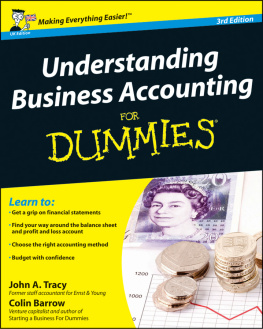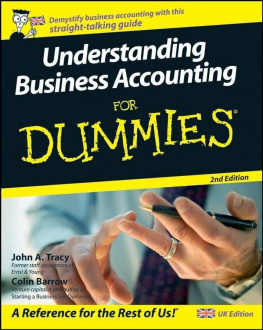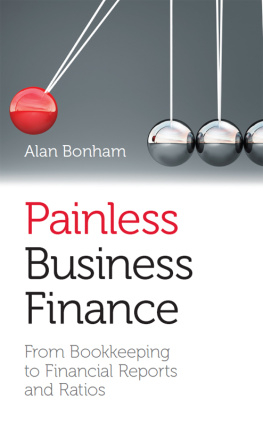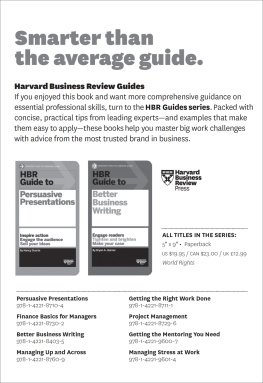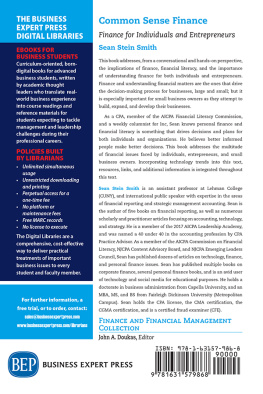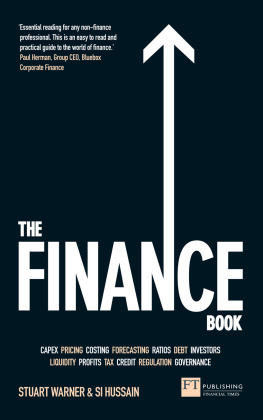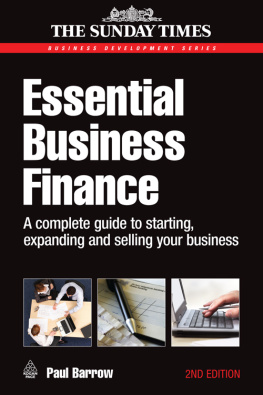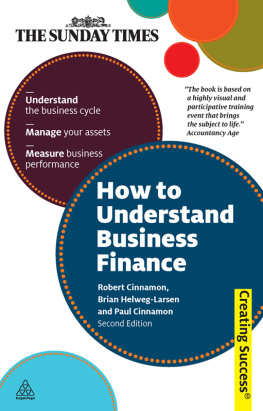1
- The bookkeeping process
- Cash flow forecasts and statements
- Calculating profit
- Balancing the books
A ccounting is the process of recording and analysing transactions that involve events that can be assigned a monetary value. By definition financial information can only be a partial picture of the performance of an enterprise. People, arguably a businesss most valuable asset, dont appear anywhere in the accounts, except for football clubs and the like where people are the subject of a transaction.
Although accounting has become more complex, involving ever more regulations, and has moved from visible records written in books to key strokes in a software program, the purpose is the same; to establish:
- what a business owns by way of assets;
- what a business owes by way of liabilities;
- the profitability, or otherwise, at certain time intervals, and how that profit was achieved.
An MBA in Finance is unlikely to be required to perform the recording side of the accounting process, except in the very smallest of organizations, or if the venture is his or her own. But it is only by knowing how accounts are prepared and the rules governing the categorizing of assets and liabilities (more on this in ) that they can gain a good understanding of what the figures really mean. For example, it is not obvious to the uninitiated that a companys shares are classed as a liability and it is extremely unlikely that the assets as recorded will realize anything like the figures shown in the accounts, audited or not. Bear Stearns, an 85-year-old investment bank, was sold for $2 (1.25/1.50) a share to J P Morgan Chase in 2008, roughly a total of $236 (151/177) million for a business that was worth $20 (12.5/15) billion only a few weeks previously. This provides a vivid insight into the gap between reported and realizable figures in the accounting world. Nevertheless, accounting reports do provide a valuable insight into business performance and in any event are a basic requirement for shareholders and regulators alike.
The aim of all accounting information is to provide the particular user with relevant and timely data to make decisions. Who are these users of accounting information and what decisions do they need to take? Possible users are an extensive group, who require the information to be impartial, accurate and timely. They include:
- Shareholders of limited companies will be influenced in their decision to remain investors or to increase/decrease their holding by receiving information about the financial performance and financial position of the company. This usually occurs twice a year in the form of a profit and loss account and a balance sheet relating to the first half-year and, later on, the full year.
- Owner-managers of non-incorporated businesses will require the above information but they will also be privy to more detailed and more frequent information about the businesss financial affairs.
- Management in companies range from director level down to supervisor level. Each person requires accounting information to help him or her in his or her role. Supervisors may be concerned with operating costs for a very small part of the undertaking. Directors need to control the overall performance of the company and make strategic financing and investment decisions. Middle managers need feedback on whether they are meeting their financial targets.
- Suppliers need to assess the creditworthiness of potential and existing customers when setting the amount and period of credit allowed. This will partly, if not mainly, be based on the financial history of each customer, so the suppliers accountants will assess the latest profit and loss account and balance sheet. Other data on payment history may be obtained from credit agencies, for example, Dun & Bradstreet, to assist in this decision.
- Customers also need to be reassured, in this case to minimize the risk of their supplies drying up and disrupting their own output. Firms entering into a joint venture will also need mutual reassurance. Similar checks to those outlined above for suppliers will need to be carried out.
- Employees and their representatives have a vested interest in the financial health and future prospects of their employer. They rely on an assessment of the published accounts by experts for this.
- Government levies tax on the profits earned by businesses and Value Added Tax (or sales tax) on the sales value of most industries. Tax authorities rely on the information provided by companies for these purposes.
- Competitors can make some comparisons, for example, sales, profit or asset utilization per employee, from published accounting data in a process known as benchmarking. This may provide clues to areas where performance may be improved particularly if explanations of differences in operating systems can be obtained.
- Lenders need to be confident that their capital is safe and that the borrowing company can service the loan or overdraft adequately, so again the financial statements of profit and loss account and balance sheet will be examined from this viewpoint.
- Partners need to keep track of business performance in much the same way as shareholders and to ensure appropriate and fair treatment by their fellow partners.
- Special interest groups ranging from Friends of the Earth, Sierra Club (environment), National Right to Life (anti-abortion), Common Cause (campaign finance reform) and PETA (ethical treatment of animals), track the accounts of companies operating in their sectors to monitor and comment on their behaviour, usually adversely.
Different users of accounting information will require different information and use it for different purposes. Accounting can be broken down into three main branches, with some overlap between, particularly in smaller enterprises where in effect all three areas will be the responsibility of a single person or department:
- financial accounting;
- management accounting; and
- financial management.
1. Financial accounting is concerned with preparing financial statements summarizing past events, usually in the form of profit and loss accounts and balance sheets. These historic statements are mainly of interest to outside parties such as investors, loan providers and suppliers.
2. Management accounting involves assembling much more detailed information about current and future planned events to allow managers to carry out their roles of planning, control and decision making. Examples of management accounting information are product costs and cost data relevant to a particular decision, say, a choice between make or buy. Also included in management accounting are preparing and monitoring budgeted costs relating to a product, activity or service. Management accounting information is rarely disclosed to outside parties, though bankers and private equity providers often ask for monthly management accounts as a condition of funding.
3. Financial management covers all matters concerning raising finance and ensuring it is used in the most efficient way. For example, it would be financially inefficient to raise a long-term loan or sell shares just to finance a short-term increase in sales. It would be the role of financial management to select and use a more cost-effective funding source such as an overdraft. The cost of capital is influenced by both the capital structure adopted and the riskiness of the investments undertaken.
Within these three broad areas of accounting there may be further subsets of accounting relating either to one specific activity, or across the whole spectrum. Examples of these are:
- treasury;
- taxation;


